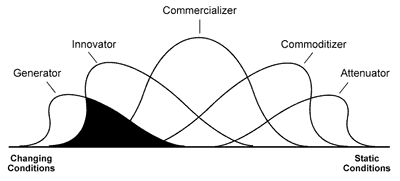The Thinking President:
1. The Generative Innovator
The real genius of the American capitalistic system has been its entrepreneurial generativity. From our earliest days, we have been driven by the generativity engines of Franklin, Hamilton, and Washington. Entrepreneurial leaders such as Edison, Ford, and Rockefeller defined the core infrastructure of the 20th century—electricity, combustion engines, motor cars, highways, and energy. Tom Watson, Sr., generated the model for “The Golden Age of American Business†in the second half of this 20th century with systems and sales of business machines and computers.
Watson was influenced by John and Frank Patterson, entrepreneurs and founders of the National Cash Register Company or NCR, one of the first modern American companies. He worked his way up to General Sales Manager of the first Sales Training School and introduced the motto “THINK!†which later became the widely-known symbol of International Business Machine or IBM. In so doing, Watson established the “Generative-Innovative Model†for American business.
For thinking people, this means that Generative-driven Innovation is the most powerful positioning in the marketplace. The secrets of the success of this model were the relationships between and among the Watson Center, the Advanced Systems Design, and the Marketing arm; e.g., the relationships between the Generators, Innovators, and Commercializers that we labeled “The GIC System.â€
The relationships between the Generators at the Watson Center and the Innovators at Advanced Systems Design were antagonistic. The Generators viewed themselves as the ruling “thinkers†who had no real responsibility for creating the market. The Innovators, in turn, viewed their roles as making the transfers of generative breakthrough ideas into the real world technological needs that create the market. In the vision of the Generator, the Innovators were “Hijackers†of the ideas of others. In the vision of the Innovators, the Generators were “Lords of the Ideal and Peasants of the Real.â€
As antagonistic as were the relations between the Generators and Innovators, the relations between Innovators and Commercializers were still more adversarial—nearly violent. Once the Innovators had ownership of technological transfers, they shepherded them like their children. The Marketers, in turn, were interested only in consumer responsiveness: Did the customers embrace the product? Did the customers use the product effectively? The Marketers were tuned-in to the customers, while the Innovators were thrilled with the technology transfers.
It was a simple step from developing the “GIC System—Generators, Innovators and Commercializers†to positioning in the marketplace (Figure 1). IBM positioned itself as “Generative Innovator.†This means that it applied and commercialized the breakthroughs that it generated. Basically, it “owned†the customer base that was increasingly oriented toward immediate innovation with the prospect of long-term generativity.
The real genius of Tom Watson, Sr., was to relate these otherwise mutually exclusive entities into one system—“The GIC System.†Watson defined the “cellular bonding tissue†for the essential secrets of success. Through continuous collaborative and sometimes interdependent processing, the solution to technological crises became the opportunities for generating new technologies.
During the decades of IBM’s “Golden Ageâ€, Watson applied his international trade perspective of ongoing “GIC Relations†to his business: “Internal productivity through operational relatedness!â€
Sadly, this principle of relatedness is, itself, no longer in operation!

Figure 1. Generative Innovator Positioning in the Global Market
The issues of globalization, jobs, and education for the 21st century Global Economy converge upon the phases of The GICCA Curve: Generators, Innovators, Commercializers, Commoditizers, Attenuators. Succinctly, America resolved all of these issues in continuous and interdependent processing for a bountiful and expanding future with “GIC Systems.â€
- Generative or “breakthrough†research by the likes of IBM’s Watson Center, AT&T Bell Labs, and Xerox Learning Center;
- Innovative contextual “transfers†of these breakthroughs by laboratory-based industries such as Microsoft and Intel;
- Commercial applications of these innovations by consumer-responsive businesses such as General Electric and Westinghouse.
These “GIC Systems†sustained and grew the American economy throughout the second half of the 20th century. In this context, the U.S. was the hope—not only for its economy—but for the economies of the world: if things work here, they can work anywhere!
